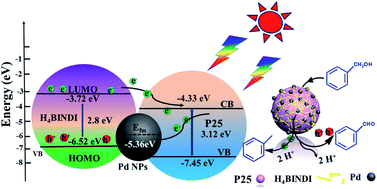Visible-light-driven selective alcohol dehydrogenation and hydrogenolysis via the Mott Schottky effect†
Abstract
The Schottky barrier created at the interface between electron sinks and semiconductors can effectively optimize electron transfer for active photocatalysis. However, heterogeneous photocatalytic organic transformations via the Mott Schottky effect are still rare and their role in the specific photocatalytic system remains ambiguous. Here, a versatile photocatalytic system integrating the Schottky junctions into the TiO2 particles (Degussa, P25) and Pd NP based films has been developed. They were readily available through the facile encapsulation of P25 by Pd–H4BINDI films using an alternating layer-by-layer (LBL) approach (H4BINDI: N,N′-bis(5-isophthalate acid)naphthalene-diimide). After a H2 reduction process under 200 °C, the Pd NPs were obtained, denoted as P25@Pd–H4BINDI-200. Interestingly, the resulting P25@Pd–H4BINDI-200 photocatalyst presented an exceptionally high activity for dehydrogenation and hydrogenolysis of benzyl alcohol under visible light irradiation, which was approximately 17 times higher than that of the parent P25@Pd–H4BINDI and was superior to any other analogous systems reported to date. Specifically, the negative charges accumulated on the Pd NP surface reduce the benzyl alcohol, while the holes left on the valence band oxidize the benzyl alcohol, effectively promoting photocatalytic cycles with enhanced carrier separation. The deeper understanding of the reaction mechanisms revealed that Pd NPs play a vital mediating role in storing and shuttling photogenerated electrons via the Mott Schottky effect, and revealed the highly enhanced carrier separation by direct use of photoexcited electrons and holes for photoredox reactions. This work holds great promise for designing Mott–Schottky catalysts in enabling solar-driven photoredox reactions.



 Please wait while we load your content...
Please wait while we load your content...